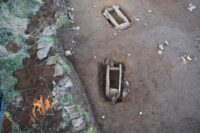 A preventative archaeology excavation in Plougonvelin, a city on the westernmost tip of Brittany, has unearthed an important necropolis from the early Bronze Age. More than 50 burials have been discovered so far, ranging in date from 2000 to 1600 B.C. This is the first Bronze Age funerary complex of this magnitude ever found in Brittany, a region famed for its Bronze Age tumuli.
A preventative archaeology excavation in Plougonvelin, a city on the westernmost tip of Brittany, has unearthed an important necropolis from the early Bronze Age. More than 50 burials have been discovered so far, ranging in date from 2000 to 1600 B.C. This is the first Bronze Age funerary complex of this magnitude ever found in Brittany, a region famed for its Bronze Age tumuli.
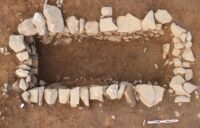 The presence of prehistoric graves in Plougonvelin has been known since the 1950s, enough that archaeologists suspected there might be a necropolis. A team from France’s National Institute for Preventive Archaeological Research (INRAP) began excavating the site of a planned real estate development in October 2020. In two months, INRAP excavated a half-acre of ground, unearthing 55 burials of notable architectural variety. There are cist tombs, wood caskets, cist tombs containing wood caskets, cairns, ones with its stone slab cover still in place, and at least one jar burial, likely of an infant.
The presence of prehistoric graves in Plougonvelin has been known since the 1950s, enough that archaeologists suspected there might be a necropolis. A team from France’s National Institute for Preventive Archaeological Research (INRAP) began excavating the site of a planned real estate development in October 2020. In two months, INRAP excavated a half-acre of ground, unearthing 55 burials of notable architectural variety. There are cist tombs, wood caskets, cist tombs containing wood caskets, cairns, ones with its stone slab cover still in place, and at least one jar burial, likely of an infant.
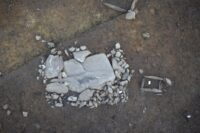 The graves are arranged and organized in a deliberate manner. Sets of tombs alternate with empty spaces suggesting the deceased were grouped in a meaningful way. The groupings do not appear to have been chronological. Archaeologists believe the concentrations of burials reflect family or community ties.
The graves are arranged and organized in a deliberate manner. Sets of tombs alternate with empty spaces suggesting the deceased were grouped in a meaningful way. The groupings do not appear to have been chronological. Archaeologists believe the concentrations of burials reflect family or community ties.
The tombs are in good condition, and analysis of the rocks used to create  them has found that the stone was locally sourced. The contents are a little worse for wear. Even the most carefully positioned stones and slabs allowed water and silt to penetrate over the millennia. Between infiltration of sediment and the highly acidic soil, the skeletal remains were dissolved.
them has found that the stone was locally sourced. The contents are a little worse for wear. Even the most carefully positioned stones and slabs allowed water and silt to penetrate over the millennia. Between infiltration of sediment and the highly acidic soil, the skeletal remains were dissolved.
Only one of the stone tombs retained enough structural integrity to 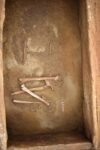 preserve the skeleton of the deceased. The bones belonged to an adult woman positioned on her right side in fetal position. Her body had been placed in an organic coffin — perhaps a basket-like material — before burial in the stone tomb. The organic container has decomposed, but its ghost remains in the imprint of her body left in a layer of hardened sand.
preserve the skeleton of the deceased. The bones belonged to an adult woman positioned on her right side in fetal position. Her body had been placed in an organic coffin — perhaps a basket-like material — before burial in the stone tomb. The organic container has decomposed, but its ghost remains in the imprint of her body left in a layer of hardened sand.
That bottom sand layer is found in most of the cists. It was an intentional deposition, not infiltration of the elements. The Bronze Age Bretons lined 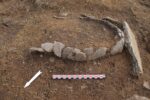 the tombs with sea sand. The consistency of the feature suggests a symbolic or ritual reference to the sea which is just a few blocks away.
the tombs with sea sand. The consistency of the feature suggests a symbolic or ritual reference to the sea which is just a few blocks away.
No surviving grave goods have been found, and in their absence establishing a chronology of the burial ground will be challenging. Researchers will study the arrangement and typology of the burials and compare them to other Bronze Age necropoli. The skeletal remains of the woman will also be studied with DNA and stable isotope analysis.